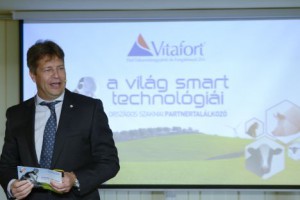Monsanto announces record 11 project advancements
Among the record 11 project advancements are the first biotechnology product with a direct consumer dietary benefit and two of the largest commercial product launches in the company’s history. These and other projects in the company’s R&D pipeline are expected to help farmers meet the unprecedented global challenges facing agriculture.
The 11 project advancements in this year’s update is one more than the company’s all-time record. Products moving forward include SDA omega-3 soybeans; Genuity™ SmartStax™ refuge-in-a-bag; and Monsanto’s first insect-protected Roundup Ready 2 Yield® soybeans designed for the Brazilian market.
The first two of Monsanto’s seven High Impact Technologies (HIT) projects – Genuity™ SmartStax corn and Genuity™ Roundup Ready 2 Yield soybeans – have graduated from the pipeline and are expected to arrive at farmer’s fields this year through broad commercial launches.
“We have talked before about being on the verge of a technology explosion, and this is the beginning of it,” said Robb Fraley, chief technology officer for Monsanto. “This year you will see the first of those game-changing products delivering on the farm. These are just the first wave of innovation. The projects in the early phases of our pipeline today will continue to fuel the next wave of technological breakthroughs and gain momentum in the years to come.”
The products coming out of the R&D pipeline today and in the future will help reset the bar for on-farm productivity and profitability, Fraley said.
SmartStax was developed in collaboration with Dow AgroSciences and approved in July 2009 with a 5 percent structured refuge for the Corn Belt, a breakthrough that will help increase yield and reduce pesticide use. Monsanto and Dow AgroSciences completed a full regulatory submission for a 5 percent refuge-in-a-bag seed blend to the Environmental Protection Agency (EPA) in December. This puts SmartStax on commercial track for the industry’s only 5 percent refuge-in-a-bag product, pending EPA approval.
A “refuge” is a portion of the field required to be planted with non-insect-protected plantings to minimize the risk of target pests developing resistance.
Monsanto and Dow AgroSciences have been researching the concept of combining biotech and refuge seeds in one bag for multiple years. Genuity™ SmartStax with refuge-in-a-bag would allow farmers in the Corn Belt to plant one corn product across their entire field without the need to plant a separate, potentially lower-yielding refuge. In addition to the convenience, this product would further promote compliance with refuge requirements. Monsanto’s refuge-in-a-bag product moved to Phase 4, the final phase before commercialization in today’s update.
Monsanto’s SDA omega-3 soybeans also advanced to Phase 4. SDA omega-3 soybeans offer a sustainable, land-based source of SDA that readily converts to the heart-healthy omega-3 fatty acid found in fish oil. Last year, the United States Food and Drug Administration (FDA) issued a Generally Recognized As Safe notice affirming that the SDA omega-3 soybean oil could be used in a variety of foods. Food companies can now formulate and test the oil from SDA omega-3 soybeans in food products for future launch. Clinical studies have shown that consumption of SDA omega-3 soybean oil significantly raises blood levels of the heart-healthy omega-3 fatty acid EPA, also found in fish and fish oils.
Each product developed by Monsanto goes through several levels of rigorous testing and development, as well as necessary regulatory approvals before commercialization.
“Our discovery engine screens thousands of genes every year to find the ones that deliver the best traits to be introduced into elite lines from the company’s worldwide germplasm base,” Fraley said. “Our strength is in continuing to deliver innovation to farmers that allow them to produce more on each acre with fewer inputs.”
Projects in the company’s yield and stress pipeline, a collaboration with Germany-based BASF, also continue to progress. The most advanced projects, drought-tolerant corn and higher-yielding soybeans, are moving as expected toward market launch. Given the absence of significant weather stress in 2009, Fraley said the company elected not to advance any yield and stress projects until more comprehensive data sets are available to generate the conclusive field research Monsanto requires to prove product performance.
The products in Monsanto’s R&D pipeline, when combined with the company’s industry-leading elite germplasm base, will help bring about a new wave of innovation that will benefit farmers around the world.
Monsanto’s technology development process includes discovery and four phases. The first phase is proof of concept, followed by early development, which includes trait development and large-scale transformation, advanced development involving trait integration, field testing and generation of regulatory data. The final pre-launch phase involves regulatory submissions, seed bulk-up and pre-marketing. Monsanto spends more than $2.6 million a day on research and development. It takes an average of 10 years and $100 million for a biotechnology product to make it to market.












Vélemény, hozzászólás?